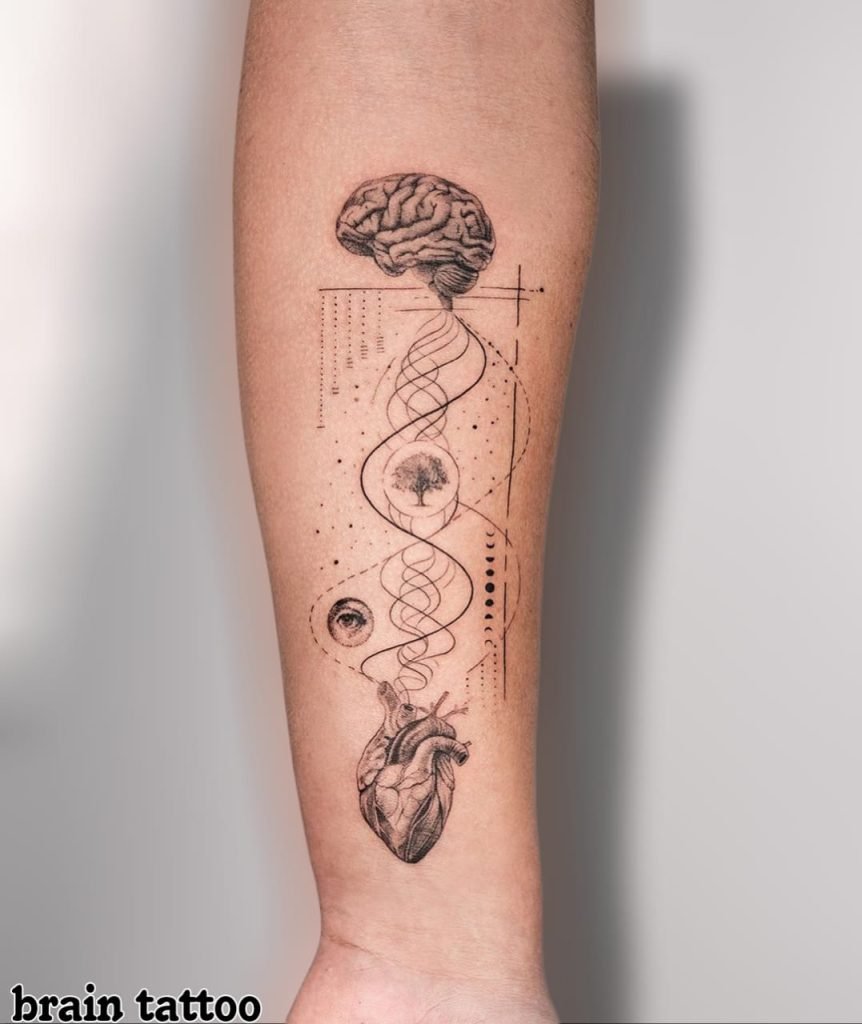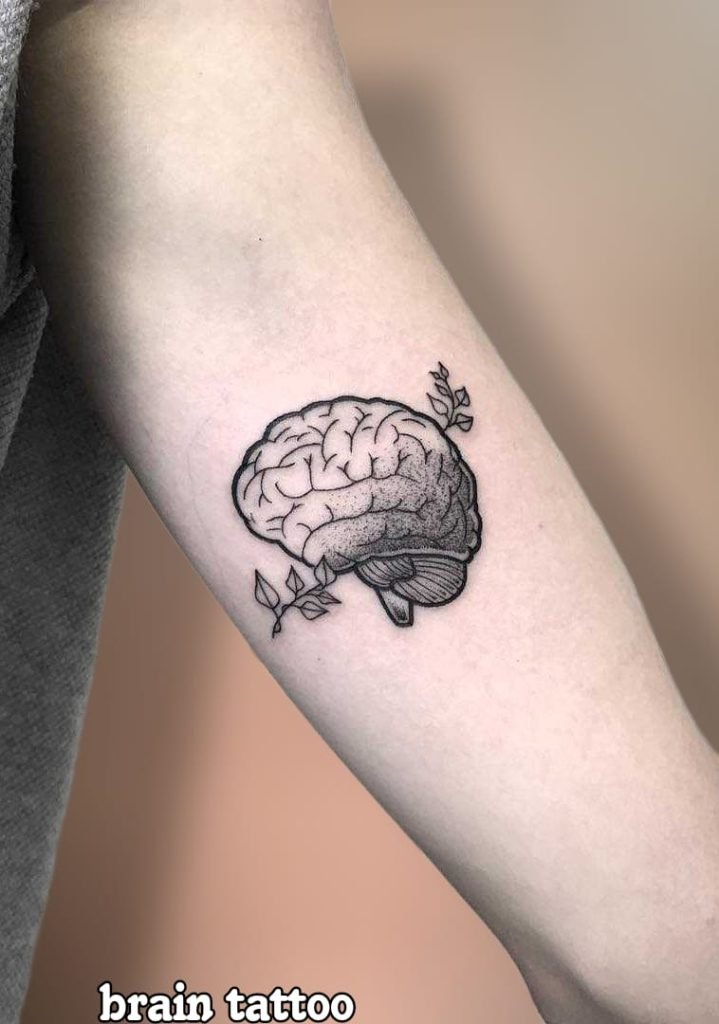Last Updated on March 17, 2024 by Umer Malik
Table of Contents
Introduction
Brain tattoo is a new and emerging field of neuroscience that involves the permanent marking of the brain tissue using specialized ink. Neuroscientists can utilize a highly advanced and sophisticated technique to study the intricate structures and functions of the brain in greater detail than ever before.
Scientists first began studying the brain using various techniques in the early 20th century, marking the inception of the history of brain tattooing. Early methods involved injecting dye into the brain tissue to map out its structure, but this was a highly invasive and dangerous procedure. It wasn’t until the 21st century that the development of specialized inks and micro-needle technology made brain tattooing a viable and safe option for studying the brain.

The Emergence of Brain Tattoo in Neuroscience
The emergence of brain tattooing has brought about a revolution in the field of neuroscience. Brain tattooing involves permanently marking brain tissue using specialized ink, which allows scientists to study the intricate structures and functions of the brain in unprecedented detail. This article will discuss the emergence of brain tattooing in neuroscience and its applications, advantages, and limitations.
The Discovery of Brain Tattoo
Brain tattooing was first discovered by accident in 2004 when researchers at the University of California were experimenting with fluorescent proteins. They accidentally injected the protein into a brain slice and found that it stained the tissue, allowing them to see the individual neurons in greater detail. This discovery led to the development of specialized inks and micro-needle technology that made brain tattooing a safe and viable option for studying the brain.
Applications of Brain Tattoo in Neuroscience Research
Brain tattooing has many applications in neuroscience research. By marking specific areas of the brain with ink, scientists can track the movement and changes in those areas over time. This allows them to study the effects of various stimuli on the brain, such as the effects of drugs, exercise, and learning on the brain’s structure and function.
Brain tattooing has also opened up new avenues of research, such as the study of neural plasticity, which is the brain’s ability to change and adapt over time. Brain tattooing has allowed scientists to study the effects of various stimuli on the brain’s structure and function, providing valuable insights into the mechanisms of neural plasticity.
Advantages of Brain Tattooing
One of the main advantages of brain tattooing is that it allows scientists to study the brain in unprecedented detail. By marking specific areas of the brain with ink, scientists can track the movement and changes in those areas over time. This provides valuable insights into brain function and behavior.
Another advantage of brain tattooing is that it has opened up new avenues of research, such as the study of neural plasticity. Brain tattooing has allowed scientists to study the effects of various stimuli on the brain’s structure and function, providing valuable insights into the mechanisms of neural plasticity.
Limitations of Brain Tattooing
Despite its many advantages, brain tattooing is not without its limitations. Highly skilled and trained professionals are the only ones who can perform the highly invasive procedure. There is also a risk of infection and damage to the brain tissue, which can lead to serious health complications. The use of brain tattooing also raises ethical concerns, particularly regarding the potential misuse of the technology.
The Science Behind Brain Tattoo
The field of neuroscience has seen tremendous growth and innovation in recent years, particularly in the area of brain tattooing. Brain tattooing involves the injection of specialized ink into specific regions of the brain to mark the tissue permanently. This technology can potentially revolutionize our understanding of the brain’s structure and function. In this article, we will delve deeper into the science behind brain tattooing, focusing on the mechanisms of brain tattooing, neural plasticity, and the impact on brain function and behavior.
Mechanisms of Brain Tattoo
The mechanism behind brain tattooing involves the injection of ink into specific regions of the brain. This ink is composed of a mixture of fluorescent proteins and dyes that allow scientists to track the movement and changes in those areas over time. The procedure is highly invasive and can only be performed by skilled professionals.
Once the ink is injected, it forms a permanent mark on the brain tissue. This mark allows researchers to track the movement and changes in the marked region over time, providing valuable insights into the brain’s structure and function. By studying the notable region’s changes, scientists can better understand the underlying mechanisms of neural plasticity.
Neural Plasticity and Brain Tattoo
Brain tattooing helps study the effects of various stimuli on the brain’s structure and function, providing insights into the mechanisms of neural plasticity, which is the brain’s ability to change and adapt over time.
Research has shown that brain tattooing can induce changes in the brain’s structure and function, particularly in the areas where the ink has been injected. These changes can last for months or even years, providing valuable insights into the mechanisms of neural plasticity. These findings have significant implications for the treatment of neurological disorders, as they suggest that the brain may be able to adapt and change in response to targeted stimuli.

Impact on Brain Function and Behavior
Brain tattooing has also been shown to impact brain function and behavior. Marking brain regions with ink enables tracking of changes over time, providing insights into brain function and behavior.
Research has shown that brain tattooing can positively and negatively affect brain function and behavior.
Brain tattooing has been linked to improved memory and learning in animal models and to increased anxiety and depression in some cases.
These findings highlight brain function’s complex and multifaceted nature and the need for continued research.
The Art of Brain Tattooing
Brain tattooing, or neural tattooing, has emerged as a new frontier in neuroscience research. This technique involves the injection of specialized ink into specific brain regions to mark the tissue permanently. In addition to its scientific applications, brain tattooing has the potential as a form of artistic expression.
This article explores brain tattooing, including techniques, safety and ethical considerations, and future directions.
Techniques and Procedures for Brain Tattooing
The technique for brain tattooing involves the injection of specialized ink into specific regions of the brain. This procedure is highly invasive and can only be performed by skilled professionals with extensive experience in neuroscience research. Brain tattooing ink contains fluorescent proteins and dyes to track brain changes over time.
The procedure involves several steps, including the use of stereotaxic surgery to guide the injection of ink into specific regions of the brain. This procedure requires high precision and accuracy to avoid damaging surrounding tissue. After the ink is injected, it forms a permanent mark on the brain tissue. It allows researchers to track the movement and changes in the marked region over time.
Safety and Ethical Considerations
While brain tattooing has enormous potential as a tool for scientific research and artistic expression. It also raises significant ethical concerns. Brain tattooing carries risks such as infection, brain damage, and even death, raising ethical concerns about using invasive procedures.
As a result, there is a pressing need for researchers and practitioners to adhere to strict safety protocols when conducting brain tattooing procedures. Furthermore, conducting research with human subjects requires considering ethical considerations. It is crucial to obtain informed consent from participants and ensure that they fully understand the risks and benefits of brain tattooing.
Future Directions in Brain Tattooing
Brain tattooing is a rapidly evolving field, and there are many exciting directions in which this technology could be developed. Researchers can consider developing new ink compositions in the future to track various types of changes in the brain. This could include changes in gene expression, protein levels, or neurotransmitter activity, among other things.
Another potential area of future research is the development of non-invasive techniques for brain tattooing. While the current method of brain tattooing is highly effective, it is also invasive and carries significant risks. Developing non-invasive techniques, such as transcranial magnetic stimulation, could open up new avenues for brain tattooing research. It is safer and less invasive.
The Societal Implications of Brain Tattooing
Brain tattooing, as a new frontier in neuroscience research, has the potential to revolutionize our understanding of the brain’s structure and function. However, as with any new technology, brain tattooing also raises significant societal implications that must be considered.
Perception of Brain Tattooing in Society
Brain tattooing is a highly invasive procedure involving injecting specialized ink into specific brain regions.
Members of the public view this technology with a certain degree of skepticism and fear, given its potential risks. Many people fear that malevolent purposes, such as mind control, may arise from brain tattooing misuse.
At the same time, there is also a growing interest in brain tattooing as a form of artistic expression. Some individuals see brain tattooing as a way to express their individuality and showcase their creativity. Overall, the perception of brain tattooing in society is complex and multifaceted, reflecting both this technology’s potential benefits and risks.
Legal and Regulatory Issues
As with any new technology, brain tattooing raises many legal and regulatory issues that must be addressed. Who owns the intellectual property rights to brain tattoos: the individual, the researcher, or the institution?
There are also questions about the legality of brain tattooing in different jurisdictions. While brain tattooing is currently legal in some countries, it is illegal in others, raising questions about the international regulation of this technology.
Potential for Misuse and Abuse of Brain Tattooing Technology
Perhaps the most significant societal implication of brain tattooing is this technology’s potential misuse and abuse. Brain tattooing can be misused to create “superhumans” by marking specific brain regions permanently. For example, someone could use it to track individuals’ movements and thoughts without their knowledge or consent.
A quick overview of brain tattoos
Brain tattooing has become an essential tool for neuroscientists, allowing them to study the brain in unprecedented detail.
By marking specific areas of the brain with ink, scientists can track the movement and changes in those areas over time, providing valuable insights into brain function and behavior.
The use of brain tattooing has also opened up new avenues of research, such as the study of neural plasticity, which is the ability of the brain to change and adapt over time.
Brain tattooing has allowed scientists to study the effects of various stimuli on the brain, such as the effects of drugs, exercise, and learning on the brain’s structure and function.
Despite its many benefits, brain tattooing is not without its risks and limitations. Highly skilled and trained professionals are the only ones who can perform the highly invasive procedure.
There is also a risk of infection and damage to the brain tissue, which can lead to serious health complications. The use of brain tattooing also raises ethical concerns, particularly in regard to the potential misuse of the technology.
Some people are concerned that brain tattooing could potentially manipulate or control the behavior of individuals or even create a new form of brain-based discrimination.
Conclusion
Brain tattooing enables the permanent marking of specific brain regions, which can aid in identifying specific brain functions. Understanding the connectivity between different brain regions provides new opportunities for studying brain structure and function. Furthermore, brain tattooing has the potential to revolutionize our understanding of neural plasticity and brain function.
Apart from that, if you want to know about Who Is Michael Eric Dyson? Michael Eric Dyson Net Worth, Early Life, And Career, then please visit our Entertainment category.
FAQs
Brain Tattooing marks specific brain regions permanently with tattoos. It enables researchers to identify specific brain functions’ locations and understand how different regions are connected.
Brain Tattooing involves injecting ink into the brain tissue using specialized needles. Researchers can track the location of specific brain functions over time by using ink designed to be permanent.
Brain Tattooing has the potential to revolutionize our understanding of the brain and its functions.
Like any medical procedure, there are risks associated with Brain Tattooing. These risks can include infection, bleeding, and damage to brain tissue. However, with proper safety precautions, these risks can be minimized.
There are significant ethical considerations with Brain Tattooing. This technology raises concerns about individual privacy and autonomy and the potential for misuse and abuse of the technology. Developing sturdy ethical and regulatory frameworks is necessary to guarantee the responsible and ethical use of Brain Tattooing.
Marking specific brain regions may enable researchers to understand the underlying causes of these disorders better and develop targeted therapies. Despite this, conducting further research is necessary to completely explore the potential applications of Brain Tattooing in this field.
Apart from this, if you are interested to know more about Is Laser Tattoo Removal Worth Your Hard-Earned Cash? then visit our Lifestyle category.



























